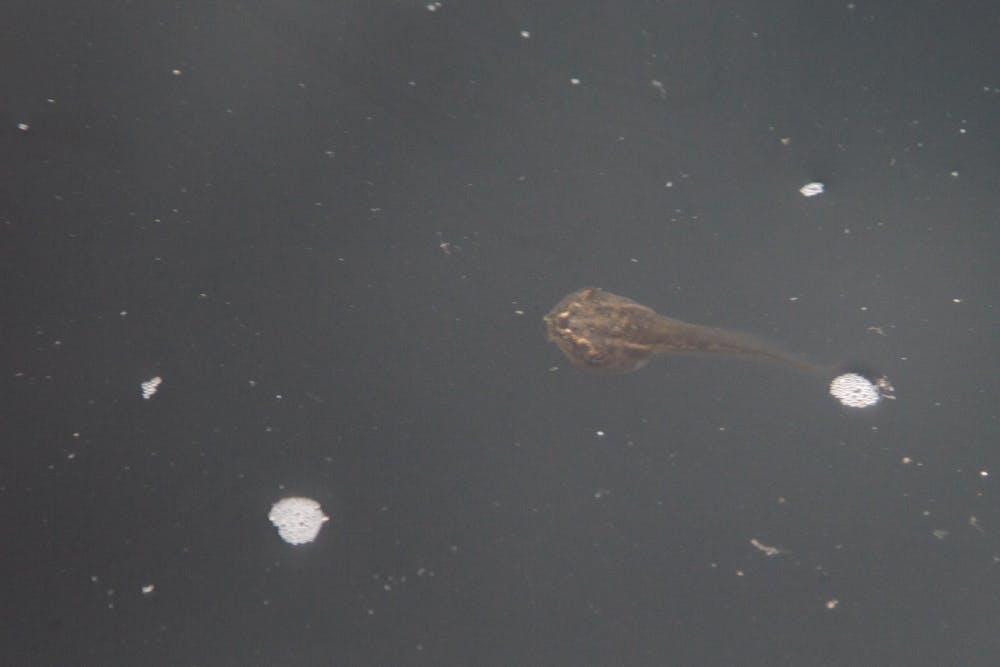Despite its algae-infested waters, the Thomas Cooper Library Fountain is an iconic centerpiece of campus. After the South Carolina women's basketball team won its national championship in April 2022, USC students jumped into the fountain's murky shallows to celebrate the victory not knowing that students are not the fountain's only inhabitants.
On hot summer days, the fountain is home to a school of tiny tadpoles darting in and around pockets of algae and bugs, feeding and growing until they mature into loud frogs that loiter around the reflecting pool when the sun sets.
The frogs are hidden gemstones. Some students, like Ray Carroll, a fourth-year public health student, have never seen the frogs. She is usually “not paying attention.” However, she said she is not surprised that they are there, despite not having seen the frogs in person.
Meanwhile Nick Vera, an information science doctoral student, has seen the frogs before, especially last year.
“I haven’t seen them in awhile,” he said. “Last summer, you could just walk at night and you would hear them.”
This is not the first year that frogs have used the fountain in front of the Thomas Cooper Library as a breeding ground to lay their eggs and swim in. Koby Padgett, the communications manager for the Division of Administration and Finance, pays close attention to the frogs and confirmed that this was not the first year this has happened.
“I think this is maybe the third year in a row this has happened,” Padgett said. “Last year, there was a massive amount of them.”
The seasonal appearances raise concerns about where the frogs may have come from and why they flocked to this specific fountain on campus.
According to Herrick Brown, the curator of the A.C. Moore Herbarium, one possible origin is the greenery surrounding the fountain, like Davis Field or the lawns around Russell House.
Brown also said that it could be a type of range expansion resulting from floods, like the one in October 2015. Frogs typically migrate away from home ponds when there are big rainfall or flooding events.
The type of frogs in the Columbia area range from ground-dwelling to tree-dwelling, meaning their foraging activities usually take place on the ground. Since frogs are amphibians, they need moisture to survive. Brown said it is detrimental for them to forage in dry environments, as there is a chance their bodies will desiccate, or completely dry out.
“Hopping around at night when it’s cooler, there’s less chance of desiccating and drying out, or after rain. That sort of thing is generally when they’ll start migrating,” Brown said. “There’s much more chance and opportunity for new recruits like tadpoles that have metamorphosed and turned into little frogs to go hopping and exploring and actually reach an area where there’s a sustainable pond.”
These frogs have found a home in the Thomas Cooper Library and Reflecting Pool. Though, it is unknown the exact species of frogs that have settled in and around the fountain, certain types of tree frogs can flourish in urban environments, according to Andrew Grosse, the state herpetologist for the South Carolina Department of Natural Resources (SCDNR).
“They’re gonna probably try to use that fountain as long as that fountain is there,” Grosse said. “From a wildlife perspective, what are their drivers? It’s food, water and reproducing ... so if they have an opportunity to breed and reproduce and pass on their genetics, they’re going to take advantage of that.”
According to Kevin Curtis, the assistant manager of landscaping at USC, maintenance cleans the fountain once a year with bleach tablets and black dye to keep the algae levels down, but Curtis said the frogs seem to have grown tolerant of these chemicals. Even though the frogs have developed a tolerance, they have no adverse effects on the fountain.
“There would be no situation where the frogs would be bad for the fountain. I can’t imagine a situation where it would be bad,” Curtis said.
Because of their persistence, it is difficult to know when the frogs may vacate the fountain and what measures can be put in place to see them safely relocated. According to Padgett, one current solution is the installation of frog ladders, which the amphibians can use to safely hop in and out of the fountain.
There has also been talk of relocation of the entire population to a pond that may be better suited for them, such as the A.C. Moore Garden, but no concrete plans have been made.
“This will be a continuing experiment,” Curtis said. “This year, we’re gonna try getting them into Moore Garden as we move them around and then trying to establish a nice population there.”
Despite the effort to move them, the frogs provide benefits to the campus environment that many may appreciate.
“They eat a lot of insects which is not a bad thing,” Rudy Mancke, the naturalist in residence at USC, said. “They don’t carry parasites. They don’t cause any great direct problem to people but they do recycle lots of insects.”
For all the benefits the frogs bring to the fountain's ecosystem, Grosse knows there are those who view frogs as annoying and will not want them there. However, he thinks the frogs should stay.
"Calls that I get throughout the year, people get upset about, you know, frog poop on their porches around their homes — people tend to think that, you know, they're overrun," he said. "People may have differing opinions and may not like it, but I think they are cool to have around and provide a pretty neat service for everyone."

